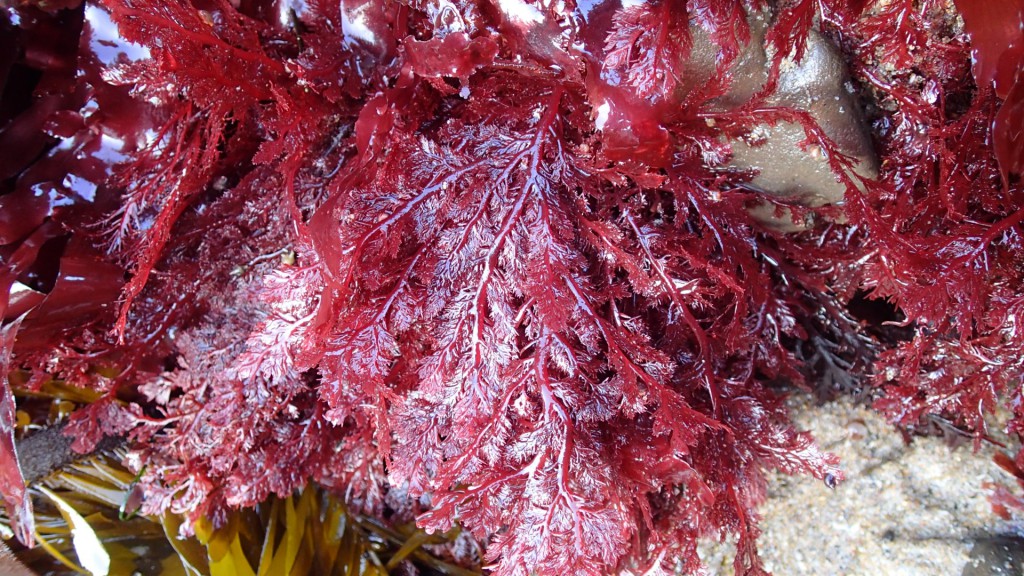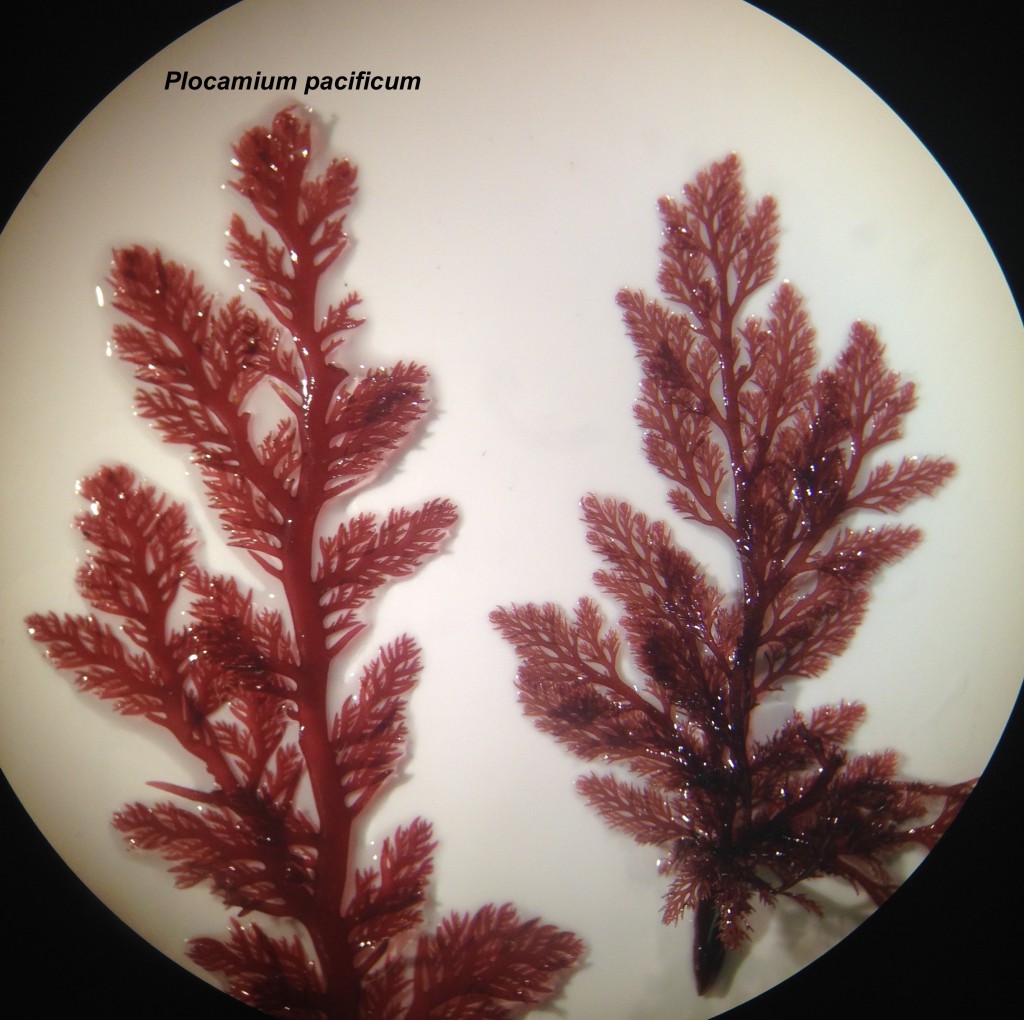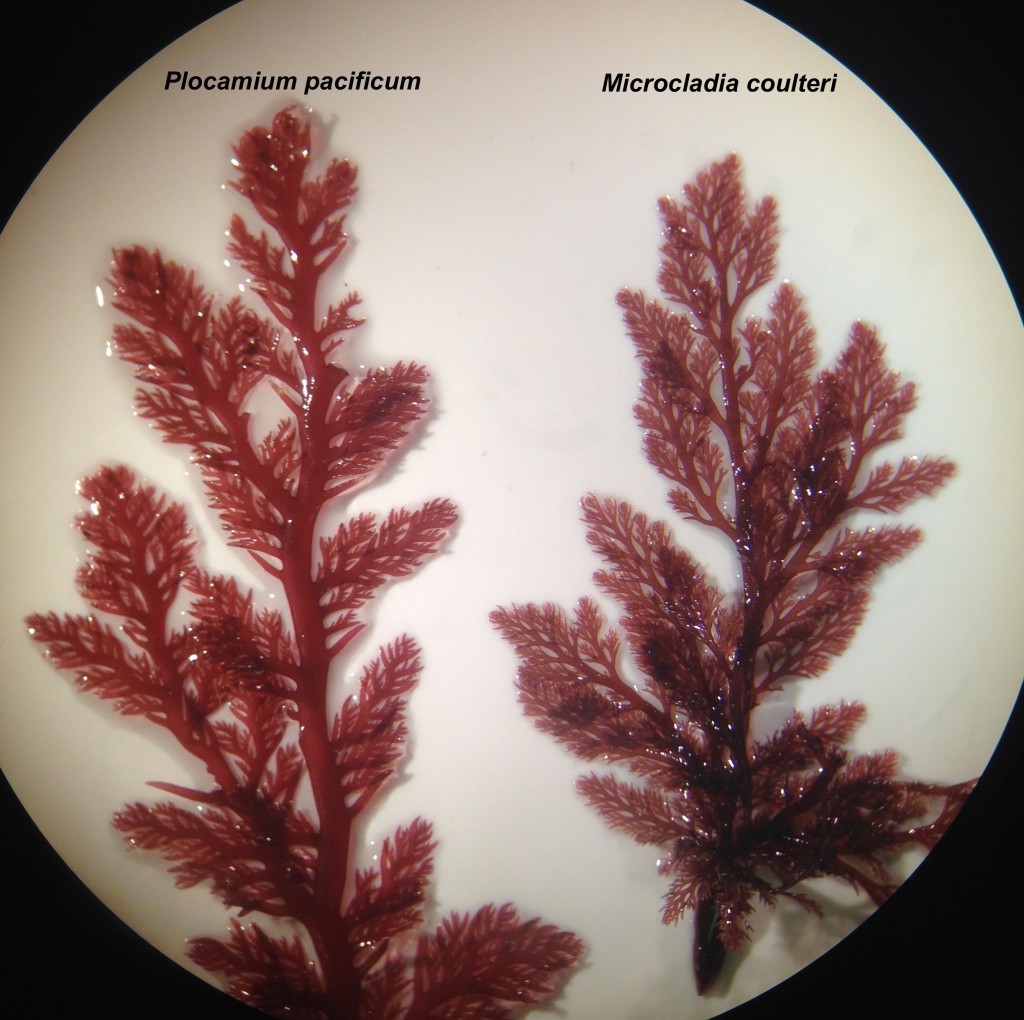If you visit the California rocky intertidal in the spring or summer, one of the first things you notice will be the macroalgae, or seaweeds. They are incredibly abundant and diverse this time of year, covering just about every bit of rock. In fact, in a landscape sense the only visible organisms are macroalgae and surfgrass:
Of the three major divisions of algae (the greens, browns, and reds), the red algae are the most diverse. We have several hundred species along the California coast, and while they don’t get as big as the kelps (which are brown algae) they display an astonishing assortment of morphologies, colors, and life history complexities. Almost all of the algae in the photo above are reds. The olive-greenish stuff? Yep, those are reds; multiple genera of reds, in fact. The dark brown things? Those are also reds, again representing more than one genus.
Within the incredible diversity of red algae, today I want to focus on two species: Microcladia coulteri and Plocamium pacificum. Both of these algae have delicate branching forms that make beautiful pressings. But despite their apparently similar morphologies, they represent different taxonomic orders and have completely different lifestyles. Let’s take a look at how similar they actually are:
Pretty tough to distinguish, aren’t they? The specimen on the left is a bit more robust in comparison, but if you had only one of these in front of you and nothing to compare it to you’d probably be hard-pressed to determine which species it is.
This is where an understanding of natural history becomes invaluable. Since these species are morphologically so similar to each other, an extremely helpful piece of information is where (and how) each one lives. In terms of habitat, these species can be found pretty much right next to each other, so that doesn’t help much. However, the surface on which each species grows tells you exactly what you need to know.
The specimen on the left in the photo above is Plocamium pacificum, a member of the taxonomic order Plocamiales. It lives from the mid-low intertidal to the shallow subtidal and is always attached to rocks, as you can see below:
The specimen on the left was taken from a thallus that was growing on a rock. This means that it is Plocamium pacificum. Now we can label our photograph with one name.
The specimen on the right was growing as an epiphyte (“on plant”) on a large blade of another red alga. This epiphytic lifestyle tells me that it is not Plocamium, but a species in the genus Microcladia in the taxonomic order Ceramiales. When I brought it into the lab to key it out I was able to identify it as Microcladia coulteri. Three cheers for natural history!
Here’s a picture of M. coulteri growing on blades of another red alga, Mazzaella sp. See how green the Mazzaella looks? Color isn’t the only factor that determines which major group an alga belongs to, and can in fact be quite deceiving!

18 June 2015
© Allison J. Gong
Finally, we have both specimens identified:
Which is all well and good when you have two specimens in hand that you can compare directly to each other. But what if all you have is this little bit?
Would you say this is Plocamium, or Microcladia? What would you base your decision on? And how certain would you be?
Submit answers (with justifications!) in the Comments, and I’ll give you the answer tomorrow.







My vote is for the Microcladia Coulteri. I’m 75% confident in my choice. The differentials I see are in the stem and the leaves mostly. The Microcladia has more curved claws at the end, which match this sample and seem to bunch in a similar way. I think the stem is more similar to the Microcladia as well.
Can’t wait to hear the answer!
Seconding Tarynleesandy – the stem and branches suggest a slightly different (less curvy, maybe?) form that looks to this untrained eye more Microcladia Coulteri-ish.
It’s beautiful and I hope you get more good pressing samples!!
I’m going to go with Plocamium pacificum. In the first picture you show, I see spiky, thorn looking protuberances and I think I also see them in the mystery picture. Since we can’t see the base to see if it attached itself to a rock or another plant (I’m assuming that the anchoring points look different) I’m not sure what other thing to look at.
You’re getting sneaky, Pamela!
I would go with Microcladia but I can’t be more than 50% sure because like you said, you can’t tell unless you see what it’s attached to! My guess is based on the proportion of the “leafy bits” to the stalk. On the Plocamium, the stalk is proportionally my thicker!
Good thinking, Kate!
I think this is Microcladia coulteri. The quickest way to tell these two apart is to look at their tiny branchlets. On Plocamium cartiligineum, the branchlets are always sympoidial, where as the branchlets on Microcladia will be more dichotomous, although sometimes they look sympoidial…..so this is where a hand lense comes in handy!